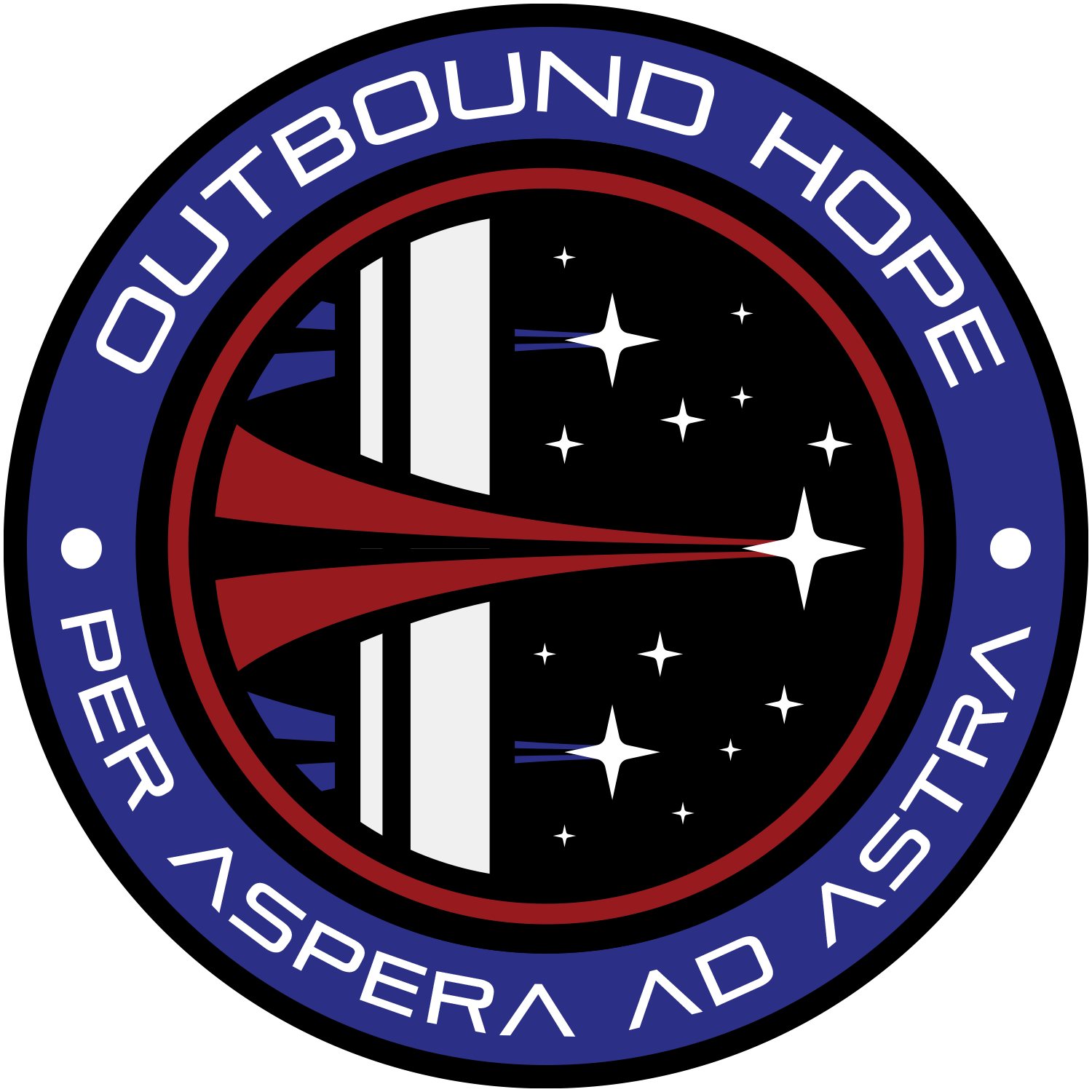AN OUTBOUND HOPE SHORT STORY
Written by Jenica Rogers
Dr. Karlyn Johnson tried not to visibly squirm in her seat. The briefing had been going on for forty minutes now, and her attention span was all but exhausted. If the information had been useful, she’d be doing more than doodling into her datapad. But this “briefing” was turning out to be essentially a glorified sales pitch by a perfectly groomed civilian in a shiny suit and shinier shoes, wearing one of those trendy data headsets. He’d been extolling the virtues of the retrofits TraumaTek was performing in the medlabs of all USSC ships headed into the Bifröst. Not a useful overview of the new tech, like how to use it, where it was being fitted, what was being bumped to make room for it… no. This was definitely just shine and polish. One more flashy holoshow of the “limitless potential” of TraumaTek’s latest toy, and nothing to justify the need for her to refresh her security clearances before she was allowed onto the attendance roster. KJ surreptitiously checked the time, and stifled a yawn.
“Don’t do that, KJ.” The whisper at her shoulder was ghost-quiet, a skill Cornelia Lincoln had perfected during similar lectures in medical school. “Yawns are contagious. And deadly. You could wipe out the entire fleet’s medical team in one boring afternoon session.”
KJ ignored Cornelia, unwilling to engage with her old friend in this setting. She tried instead to look like the Chief Medical Officer she so-newly was, to pay attention before they got themselves in trouble with the brass. They were too senior in rank now — not to mention too old! — to keep getting into trouble like they did in their academy days.
“… and so the Quantum Scanner in a BioBed is a branching of the technology developed by Windfall when it created the Limited Skip Drive. Specifically, they’re the scanning segment of the technology developed, with no connection to the space-folding segment of the drives, and so are in no way limited by the terms of the Treaty of Titan.”
KJ sat up straighter. When had the droning suit stopped talking about the HADTU? What did the Treaty have to do with medical technology? She studied the image on the holodisplay. “The BioBed: TraumaTek’s medical regenerator, putting an end to unnecessary battlefield casualties.”
Cornelia also started paying attention. “Yeah, right. Battlefield casualties will end when we’ve killed everyone.” Years-old disdain for humanity’s aptitude for killing itself laced Cornelia’s whisper. KJ smirked. She was probably right.
“The BioBed works by combining quantum tunneling scans with your personal nanites, creating a mesh network that is capable of direct regeneration. The BioBed’s ability to effectively raise the dead is an active partnership between the established nanite network and the scan held in those nanites, which is read by the BioBed. Neither the nanite network nor the BioBed can independently regenerate a patient; they must work in concert.”
As KJ stared in bafflement, and Cornelia muttered, “Raise the dead? What the-?” The screen changed, now reading “The BioBed is deemed the terminal development of nuclear medicine!” Lewis Eigen, sitting behind Cornelia and KJ, leaned forward. “If they’re serious, this is a damned quantum miracle!”
“This contract between TraumaTek and the USSC for the Outbound Hope Mission is revolutionary for our modern military. In the free market, there are very few who can afford a BioBed, or access to one. Patients buy access to a BioBed service by subscription, which includes one annual scan, but can opt for an additional service fee to schedule update scans as desired. The parent company owns all patient data and scans in perpetuity. The implementation of BioBeds, nanite mesh systems, and routine scans in our military is a premium privilege for those who step forward to enlist, or join certain branches of the government’s service. Nanites will be administered as part of standard inoculation schedules for all selective service candidates. After 6 months, the candidate’s nanite network will be stable and saturated into all tissues.”
Eigen breathed out in wonderment. “That’s… Stars and Stones, that’s … wow…” KJ was caught between Cornelia, seething beside her, and Eigen behind her, who seemed to be having a religious epiphany.
The suit continued. “Legally, the BioBed can only be used on dead patients. This is a hard coding into the machine itself, and cannot be bypassed.”
KJ muttered “How does that mesh with Do No Harm?”
Cornelia’s sardonic whisper came on top of KJ’s. “Morally, they’d have to do it that way, because who could get it out of ethics committee otherwise?”
The suit was ignoring the increasingly loud low buzz in the audience. “To address one of the most-voiced ethical concerns raised by this revolutionary technology — no, you cannot copy a person. The independent nanotech mesh must be present in all tissues in order for the BioBed to operate. Nor can it resurrect our ancestors; 72 hours postmortem, the nanites begin to lose the mesh connection as Low-E, low-emission, signals can no longer be maintained. Therefore, the BioBed will also cease to be effective 72 hours post-mortem, and will reject tissues that do not have an active nanite mesh.”
KJ could feel Eigen deflate at that revelation. Who had he hoped to resurrect?
“…requires proto amino acids in order to complete regeneration in patients who require additional mass to regain their original state. To make more of the raw acids, TraumaTek integrates state-of-the-art quantum scanning equipment and nanofacturing capability.” He took in the audience, the whispering and excitement, and looked deeply pleased with himself. “I will now take questions.”
The audience exploded into waving hands and shouted questions. Someone in command was obviously choosing to activate certain officers’ microphones, though, as one voice was suddenly piping through the speakers.
“No, hold up: Tell us more about the nanites. I understood the nanites had to do with standard techniques for stabilizing an injury — we all just got HADTU training. They can also raise the dead?”
The suit smiled. “Yes and no, Doctor. Nanites can maintain and record very basic biological data as interpreted by the HADTU and similar equipment. They are programmed to recognize when hemorrhaging is occurring, for example, and function as an added clotting agent. That’s very simple if-then programming. It is not, however, the solution for kidney failure. In layman’s terms, they’ll make it easier to staunch a wound, but won’t repair the wound on their own.”
A new voice — a doctor seated to KJ’s forward right, who she’d met briefly at a reception earlier in the week — asked the next question. “If I extract all of someone’s nanites, then can I copy the person?”
The suit’s smile grew wider. The guy was clearly expecting these questions. “No. The nanites work in concert with the cellular structure of the body, creating a contextual mesh computing network that cannot operate independently of that context.”
Reception Doctor continued. “What if I can only find the patient’s right leg? Can I regenerate them?”
Unrattled, the suit’s answer was swift. “Nope. Nothing happens.”
Reception Doctor pressed on. “What if my patient lost the leg, but I found the body, not the leg? Then what?”
“Yes! In that case, you can regenerate the patient. You have the majority of the body, and therefore have most of the mesh network, so you can regenerate fully, including the lost leg. Of course, remember, the patient must have died first!” That cheerful final admonishment sent a chill down KJ’s spine. Do no harm, she thought. What if killing the patient is how you do no harm?
A new voice rang out. “So, are the nanites capable of a remote diagnostic, then? Since they’re creating a computer out of my body?”
“No. Nanites are NFC — sorry, Near Field Communications — only. They don’t have the capability of transmitting, nor do they analyze or do much of anything, on their own. They are really only useful in conjunction with TraumaTek medical equipment designed to partner with their mesh networks.”
“So they’re not a remote tracking device.”
“No. The Low-E signal power they’re capable of creating can’t be detected outside of touch range of the human body.”
Cornelia’s voice echoed acidly through the room as she stood and asked her question. “TraumaTek is not a subsidiary of Windfall. It is a competitor. How did you get your hands on LSD technology?”
The suit’s smile was no longer just satisfied — it was now downright smug. “Our research division, who had been dreaming of just this kind of innovative and transformative discovery, took advantage of a very enticing government research opportunity following the Treaty of Titan. In doing so, we discovered that the Public Information Sharing and Distribution Act of 2094 still applied to certain Windfall-initiated developments which were based on foundational technologies that had been publicly funded. We capitalized on that discovery, and now humanity will benefit.”
Cornelia sounded even more annoyed. “So, are you testing them on us? How long have these things been in use?”
The suit finally looked slightly uncomfortable. “The first decade of their use was classified. But rest assured, they have been properly tested for the commercial market — they are more than safe enough for the military.”
A discreet buzzer sounded, and the lighting in the conference room shifted to blue, signaling the end of the session.
The suit gave a smile he probably meant to be sincere. “Thank you for your time, doctors. And for your service on the Outbound Hope Mission! Per Aspera Ad Astra!”
TO ADMIRAL PETER KOHLER
PER ASPERA AD ASTRA – OUT OF HARDSHIP TO THE STARS



